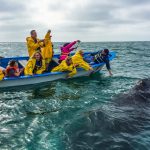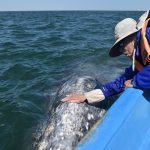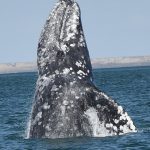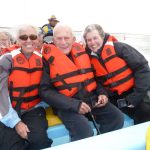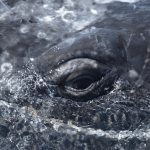
Life-changing, a wild adventure, awesome, stunning, and intense were a few adjectives used by those who’ve witnessed gray whales during their annual migration to spawn in the lagoons of Baja California Sur, Mexico.
“It was going beyond just a wild experience, it was a special nature connection for me meeting up in the wild with large mammals in the water,” said Point Loma resident Barbara Booth Keiller, Ph.D., a psychologist who recently returned from her sixth Baja whale-watching trip. “It was an adventure open to possibilities. I’ve always loved the ocean, loved the water. In a lot of ways, it expands your view of the world.”
“The whale moms go into the lagoon by the hundreds,” noted Dimitri Deheyn, Ph.D., a Scripps Institution of Oceanography research scientist, about the vacation he and his 12-year-old son, Bryce, went on to view the Baja gray whales. The duo wasn’t disappointed.
“There were about 1,400 moms and calves in the lagoon,” noted Deheyn. “Anywhere you looked you saw whales in very shallow water. You can see these big animals swim under your boat. They like to play and come to touch your boat. They are very curious and, eventually, they come to you next to the boat.”
“Mexico was awesome,” exclaimed Bryce Deheyn. “The fishing was fantastic. And the whales were stunning.”
“I’m still dreaming about whales,” said Mary Coakley Munk describing the Birch Aquarium-sponsored, whale-watching excursion she and her late husband, famed oceanographer Walter Munk, took in 2011.” Walter summed the experience up best when he said, ‘If you didn’t have religion before you went – you certainly had some when you came home.’”
“It is not a myth or legend what it means to look into the eye of a whale,” noted Terry Kraszewski, a La Jolla Shores boutique owner who accompanied the Munks on their whale-watching excursion. “The experience does change you forever.
“The fact that, in this lagoon where whales were slaughtered, a mother whale will still bring her baby to meet you. To me, is the ultimate act of forgiveness. I was privileged to be in the company of Walter Munk and other renowned scientists and friends. We were all able to touch whales and gaze into their magical eyes. It was a first for all of us, which made the experience even more remarkable and memorable,” Kraszewski said.
One of the lagoons the gray whales migrate to annually, Ojo de Liebre lagoon, is about 533 miles from the San Diego border. It is in the middle of the Baja California peninsula next to the town of Guerrero Negro in the State of Baja California Sur, Mexico. This extensive lagoon is more than 27 miles inland and has an average width of 7 miles. It can be described as a series of intricate, narrow channels separated by shallow sand bars.
Next to this lagoon are Guerrero Negro Lagoon and Manuela Lagoon. All together, they form the Lagoon Complex of Ojo de Liebre. The town of Guerrero Negro, population around 15,000, is adjacent.
The gray whales congregate in the lagoons during winter to mate, give birth, and let their calves grow enough to withstand the long migration north to Alaska. The first whales start arriving as early as Dec. 20 and leave completely as late as April 10. The females have most of their calves inside the lagoon, while the males remain outside. Most babies are born the first week of February.
In mid-February, Ojo de Liebre lagoon hosts up to 50% of the gray whale calves born each year, or what is about 800 newborn whales. The babies never separate from their mothers more than a couple of feet while in the lagoon.
This spot has the highest density of whales anywhere in the world. And it is a unique and outstanding natural phenomenon that brings incredible opportunities to witness one of the biggest animals on the planet performing incredible displays of strength, speed, and, at the same time, the unbelievable care and delicate touch that they display with their calves and the humans in pangas.
Farther south, gray whales raise their young and hide from orcas in the sheltered and shallow waters of the Bay of Magdalena. In this narrow bay, mothers and calves can be easily spotted just minutes offshore. They are also known to welcome interaction from humans.
Two-hour whale watching trips in the Bay of Magdalena take off from the towns of Puerto San Carlos and Puerto Adolfo Lopez Mateos. The trips take place on pangas helmed by local fishermen. Tours can be arranged by tour providers in La Paz, the state’s capital three hours drive away, or upon arrival at the dock. Tour packages from La Paz typically include transportation to and from Lopez Mateos, breakfast and lunch, and two hours of whale watching.
Booth Keiller said Baja whale watching is a big draw for her, adding she keeps going back because she feels a “soul connection” with the whales and nature. “It’s a real gift,” she says of the species interaction.
“We were absolutely overwhelmed with delight and filled with such complete joy,” agreed Kraszewski about her life-encouraging gray whale encounter. “We all rededicated ourselves to protecting our ocean, planet, and also our new wonderful whale friends.”
“The panga drivers are truly remarkable,” recalled Coakley Munk of the whale-watching experience. “They know the whales and the whales know and trust them. The mothers bring their babies to the panga and lift them up for all those on board to admire and even touch and hug. It is a surreal and life-changing experience to have such personal contact with these majestic animals. Walter and I traveled the world, but this trip touched our souls. It’s a must-do on your bucket list.”
A BLOODY HISTORY
Charles Melville Scammon (1825-1911), one of the most successful 19th-century whalers of his time, became a naturalist and author. He is believed to have been the first to hunt the gray whales of both Laguna Ojo de Liebre and San Ignacio Lagoon in Baja California Sur. The former was named “Scammon’s Lagoon” after him.
While his name has become synonymous with hunting and slaughtering gray whales in their Mexican lagoon breeding grounds, Scammon was also one of the most literate men of his time. He was an artist, a self-trained naturalist, and an accomplished writer. Born in Maine in 1825, he settled in California with his wife in 1853. For 10 years he commanded his own whaling vessel all along the Pacific coast, hunting the gray whale from San Francisco.
Scammon began to astonish other whalers by returning to San Francisco with a ship full of whale oil after only being out a short time. He had accidentally discovered a lagoon halfway down the Baja California peninsula that can be entered only through a long narrow mouth.
The shallow Ojo de Liebre (Scammon’s) Lagoon and the San Ignacio Lagoon are the breeding grounds of the California gray whale. Prior to the discovery by the whalers, there were an estimated 18,000 to 22,000 whales migrating there annually from colder Alaskan waters. After Scammons’ “secret” about Baja’s gray whale birthing lagoons leaked out, other whalers headed there in record numbers to fill public demand for whale oil.
Of this human migration and the subsequent whale hunt, Scammon wrote: “The objects of our pursuit were found in large numbers … the slaughter was exceedingly picturesque and unusually exciting. The stricken animals, in their efforts to escape, can be seen darting in every direction through the water or breaching headlong clear of its surface. The whole spectacle is beyond description, for it is one continually changing aquatic battle scene.”
Once the slaughter of the California gray whales began it didn’t stop completely until 1937 when Mexico and the United States forced international laws to protect the whales. The international agreement of 1938 protects all members of the species wherever found. The agreement came just in time, as estimates are that the Baja whale population by the 1930s was down to only about 250 animals. The current California gray whale population is now comparable to what it once was 150 years ago.
When Scammon left whaling, he returned to San Francisco and in 1874 published “Marine Mammals of the Northwestern Coast of North America” and “An Account of the American Whale Fishery.” His pencil- and water-color sketches and systematic descriptions of marine mammals were used for decades by scientists and researchers.

